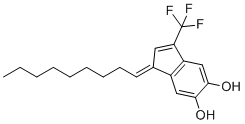| Description |
E64FC26 is a highly potent pan-style inhibitor of Protein Disulfide Isomerase (PDI) with IC50 of 1.9 uM (PDIA1), also inhibits all other members of the PDI family, including PDIA3, PDIA4, TXNDC5, and PDIA6; induces robust ER stress response in MM cells, with expression of ER stress markers ATF4 and CHOP; induces an oxidative stress response in a panel of heterogeneous PI sensitive and resistant cell lines that was characterized by the induction of Nrf2, synergistically enhances the anti-MM cytotoxic effects of PIs; improves survival and enhanced the activity of bortezomib without any adverse effects.
|
| Related Catalog |
|
| In Vitro |
E64FC26 (0.01-100 µM; 24 hours) shows anti-MM activity , with an EC50 of 0.59 μM[1].E64FC26 is more cytotoxic against a genetically diverse panel of multiple myeloma (MM) cell lines (KMS11, OPM2, MM.1S BzR, MM.1S, SA-13, U266 BzR, ANBL6, KMS12PE, U266, 8226 DxR, 8226 BzR, KMS12BM, H929,8226 cells) when compared to non-malignant cells[1]. Cell Viability Assay[1] Cell Line: MM.1S BzR cells Concentration: 0.01, 0.1, 1, 10, 100 µM Incubation Time: 24 hours Result: Showed anti-MM activity , with an EC50 of 0.59 μM.
|
| In Vivo |
E64FC26 (2 mg/ kg; i.p.; three days a week for 7days) shows anti-MM effect in NSG mice model, and increases median survival by 2 weeks[1]. The combination of E64FC26 and Bortezomib produced the greatest improvement in survival, extending the median survival by 20 days[1]. Pharmacokinetic of E64FC26 was measured in CD-1 mice. E64FC26 was administered i.v. (2 mg/kg; gray tracing) or p.o. (5 mg/ kg; blue tracing) and plasma drug concentrations were measured over a 24 h period. In CD-1 mice demonstrated adequate oral bioavailabilty of 34% with systemic exposure approaching a maximum concentration (Cmax) of 400 nM after a single oral dose of 5 mg/kg with a terminal half-life of 9.5 h[1]. Vk*MYC transgenic mice are treated with E64FC26 (2 mg/kg, i.p., 3 days/week) for two consecutive weeks. E64FC26 treatment induces an immediate anti-MM response, decreasing serum M-protein in all mice by an average of 33 ± 7.9%[1]. Animal Model: NOD-SCID IL2Rγ-/- (NSG) mice (bearing MM.1S cells)[1] Dosage: 2 mg/ kg Administration: i.p.; three days a week for 7days Result: Showed a clear anti-MM effect in this model also, increasing median survival by 2 weeks.
|
| References |
[1]. Robinson RM, et al. Inhibitors of the protein disulfide isomerase family for the treatment of multiple myeloma. Leukemia. 2019 Apr;33(4):1011-1022.
|
